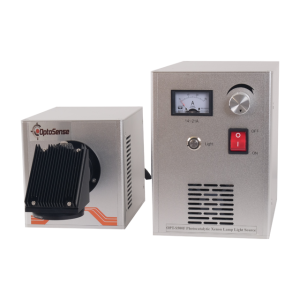Xenon Light Source

A xenon light source, often referred to as a xenon lamp or xenon arc lamp, is a specialized type of gas-discharge lamp that produces a bright and broad-spectrum light. It operates by ionizing xenon gas to generate a high-intensity white light that closely simulates natural sunlight.
SALE PRICE: RFQ
Xenon light sources have several advantages, including their ability to produce a continuous and broad-spectrum light, which closely matches natural sunlight. This characteristic makes them valuable for applications that require accurate color reproduction and high-intensity illumination. However, they also have limitations, such as their relatively high power consumption and the need for cooling systems to dissipate the heat generated during operation. Newer technologies, such as LEDs, have become more energy-efficient and have largely replaced xenon lamps in many applications.
WORKING PRINCIPLE OF XENON LIGHT SOURCE
The working principle of a xenon light source, also known as a xenon arc lamp, involves the ionization of xenon gas to produce a high-intensity, broad-spectrum light. Here’s a step-by-step explanation of its working principle:
–Gas Discharge: The xenon light source consists of a glass or quartz bulb filled with xenon gas at high pressure. The bulb has two electrodes, typically made of tungsten, at opposite ends. When an electrical voltage is applied across these electrodes, a high-voltage discharge is initiated.
–Ignition: Initially, a trigger electrode or a starter mechanism generates a high-voltage pulse to establish an electrical arc between the two main electrodes. This arc initiates a discharge within the xenon gas.
–Ionization: The electrical discharge ionizes the xenon gas atoms, meaning it strips electrons from the xenon atoms, turning them into positively charged ions. These ionized xenon atoms are in an excited state, characterized by the presence of electrons in higher energy levels.
–Emission of Light: As the ionized xenon atoms return to their ground state (the lowest energy level), they release the excess energy in the form of photons. This photon emission results in the production of a bright and broad-spectrum light that closely simulates natural sunlight. Xenon light sources emit light across a wide range of wavelengths, including visible, ultraviolet (UV), and infrared (IR) regions.
-Color Spectrum: Xenon lamps produce a continuous and balanced color spectrum, making them suitable for applications that require accurate color reproduction.
–Stabilization: To maintain stable and consistent light output, xenon lamps often incorporate feedback and control systems that regulate the electrical current and temperature. These systems help manage the intensity and color temperature of the emitted light.
–Cooling: Xenon lamps generate a significant amount of heat during operation. Therefore, cooling systems, such as fans or heat sinks, are commonly used to dissipate the heat and prevent the lamp from overheating.
The key characteristics of xenon light sources include their high brightness, wide spectral range, and balanced color rendering, making them valuable for applications in microscopy, spectroscopy, medical instruments, and other fields where accurate and intense illumination is required. However, they also have limitations, such as relatively high power consumption and a finite lifespan, which can be a concern in some applications. In recent years, light-emitting diodes (LEDs) have become increasingly popular due to their energy efficiency and longer operational life, causing xenon lamps to be phased out in certain applications.
What are the usage areas of xenon light source?
Xenon light sources have a variety of applications across different fields due to their unique characteristics, which include high brightness and a broad-spectrum, daylight-like light. Some common usage areas of xenon light sources include:
Medical and Scientific Instruments:
-Endoscopy: Xenon light sources are used in endoscopes to provide bright and natural lighting for medical procedures, such as minimally invasive surgery and diagnostic examinations.
–Microscopy: In fluorescence and confocal microscopy, xenon lamps are used to excite fluorescent dyes, allowing researchers to visualize and study biological samples with high contrast and color accuracy.
–Spectrophotometry: Xenon light sources are used in spectrophotometers for accurate absorption and emission spectroscopy in chemistry and material science.
Projection Systems:
–Xenon lamps have been traditionally used in cinema projectors and older generations of digital projectors for their ability to provide high-quality and vivid images with accurate color reproduction.
Industrial Inspection:
-Xenon light sources are used in machine vision systems and industrial cameras for inspecting and quality control in manufacturing processes, where intense and uniform lighting is essential for image capture and defect detection.
Aviation and Aerospace:
-Xenon lamps can be used in aviation lighting and aircraft landing lights, providing high-intensity illumination for pilots during takeoff and landing.
Entertainment and Stage Lighting:
–While newer technologies like LEDs have become more common in stage lighting, xenon lamps were historically used in theaters, concerts, and other entertainment events due to their color accuracy and brightness.
Photolithography:
–In the semiconductor manufacturing industry, xenon light sources are used in photolithography equipment to project circuit patterns onto semiconductor wafers, an essential step in semiconductor chip fabrication.
Solar Simulation:
–Xenon lamps are used in solar simulators to replicate natural sunlight for testing and characterizing solar cells, panels, and other solar energy technologies.
Searchlights and Spotlights:
–Xenon lamps are used in high-intensity searchlights and spotlights, such as those used for search and rescue operations, military applications, and outdoor events.
Materials Testing and Research:
–Xenon lamps are employed in materials testing and research laboratories for various experiments requiring controlled and intense light sources.
Art and Restoration:
–Xenon light sources are used in art restoration and conservation for examining and restoring artworks and historical artifacts, providing a high-quality light source for detailed examination.
While xenon light sources have historically been widely used, they are being gradually replaced by light-emitting diodes (LEDs) in some applications due to the energy efficiency and longer operational life of LEDs. However, xenon lamps continue to be valuable in specific applications where their unique characteristics are essential for accurate color rendering and high-intensity illumination.
